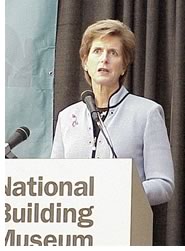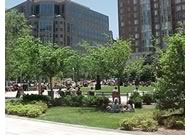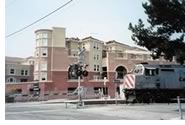
The U.S. Environmental Protection Agency honored local, state, and regional governments for establishing innovative smart growth programs that minimize environmental impact and maximize public investment during its first presentation of the National Awards for Smart Growth Achievement at the National Building Museum in Washington, D.C.
 "The
driving force of smart growth is to provide each American with greater
quality of life by developing healthy communities with flourishing economies,
open space for parks and recreation, and convenient transportation choices,"
U.S. EPA Administrator Christine Todd Whitman said at the November 18
ceremony. Since 1998, Whitman said, "voters across America have passed
over 500 referendums supporting more than $20 billion in open space funding.
Two weeks ago, voters in 79 communities in 22 states passed ballot measures
to support $2.6 billion in new funding to protect land for parks and open
spaces."
"The
driving force of smart growth is to provide each American with greater
quality of life by developing healthy communities with flourishing economies,
open space for parks and recreation, and convenient transportation choices,"
U.S. EPA Administrator Christine Todd Whitman said at the November 18
ceremony. Since 1998, Whitman said, "voters across America have passed
over 500 referendums supporting more than $20 billion in open space funding.
Two weeks ago, voters in 79 communities in 22 states passed ballot measures
to support $2.6 billion in new funding to protect land for parks and open
spaces."
The EPA developed the program in part to help promote smart growth success stories. "Given what's at stake," Whitman said, "it is no surprise that Americans are eager for smart-growth projects for their communities."
The agency honored four projects in as many categories:
 Overall
Excellence: Arlington County, Va., planned dense, mixed-use development
at Metro stations in the Rosslyn/Ballston Corridor, creating vibrant suburban
villages where people live, shop, work, and play using transit, pedestrian
walkways, bicycles, or cars. (Click
here to read more about this project.)
Overall
Excellence: Arlington County, Va., planned dense, mixed-use development
at Metro stations in the Rosslyn/Ballston Corridor, creating vibrant suburban
villages where people live, shop, work, and play using transit, pedestrian
walkways, bicycles, or cars. (Click
here to read more about this project.)
 Built
Projects: The Breckenridge Planning Development, Colorado, helped
the Wellington Neighborhood recycle land, create affordable housing for
working families, and provide free transit to the nearby downtown. The
program also helped the region avoid "mountain sprawl." (Click
here to read more about this project.)
Built
Projects: The Breckenridge Planning Development, Colorado, helped
the Wellington Neighborhood recycle land, create affordable housing for
working families, and provide free transit to the nearby downtown. The
program also helped the region avoid "mountain sprawl." (Click
here to read more about this project.)
 Policies
and Regulations: The San Mateo City/County Association of Governments,
California, impressed the review committee with its Transit-Oriented Development
(TOD) Incentive Program. The organization uses transportation funds to
help towns that build housing near rail stations, directly linking land
use with efficient use of the existing transportation system. (Click
here to read more about this project.)
Policies
and Regulations: The San Mateo City/County Association of Governments,
California, impressed the review committee with its Transit-Oriented Development
(TOD) Incentive Program. The organization uses transportation funds to
help towns that build housing near rail stations, directly linking land
use with efficient use of the existing transportation system. (Click
here to read more about this project.)
 Community
Outreach and Education: The Massachusetts Executive Office of Environmental
Affairs garnered this award for its Community Preservation Initiative,
a statewide smart growth program that helps municipal officials and community
leaders make more informed choices by increasing their understanding of
the potential effects of future growth. (Click
here to read more about this project.)
Community
Outreach and Education: The Massachusetts Executive Office of Environmental
Affairs garnered this award for its Community Preservation Initiative,
a statewide smart growth program that helps municipal officials and community
leaders make more informed choices by increasing their understanding of
the potential effects of future growth. (Click
here to read more about this project.)
The agency selected the winning entries from the more than 100 applications it received based on their ability to be replicated, effectiveness in advancing smart growth, and the level of citizen and stakeholder participation or partnership. The competition was open to state, regional, or local governments and other public-sector entities. The award recipients were chosen through a multistep process. A panel of external experts representing a broad range of constituencies with interest and expertise in the built environment and smart growth provided advice. An internal EPA review panel then provided additional comments on the entries. The EPA associate administrator for policy, economics, and innovation made the final award determinations.
Copyright 2002 The American Institute of Architects. All rights reserved.
![]()
|
D.C. area public officials, including Christopher Zimmerman, chair of the Arlington County, Va., Board of Supervisors, and Maryland Gov. Parris N. Glendening recently spoke at a smart growth summit held at the University of Maryland, College Park, and sponsored by the Washington Region Architects and Planners. Click here to read their comments. The principles of smart growth include: The U.S. EPA Smart Growth Web site has contact information for each of the award winners. |
|